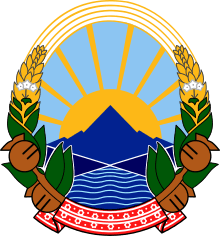Greece–Republic of Macedonia relations
 |
|
Greece |
Macedonia |
|---|---|
Greece – Macedonia relations refer to the bilateral relations between the Hellenic Republic and the Republic of Macedonia.
Greece has a Liaison Office in Skopje and an Office of Consular, Economic and Commercial Affairs in Bitola. [1] Similarly, the Republic of Macedonia maintains a Liaison Office in Athens and an Office for Consular, Economic and Commercial Affairs in Thessaloniki.[2]
Relations
Ever since the Republic of Macedonia broke away from former Yugoslavia, Greece has refused to recognize its name.[3]
The provisional reference the former Yugoslav Republic of Macedonia (FYROM)[4] is still currently used in relations with Greece. Nevertheless, all United Nations member-states have agreed to accept any final agreement resulting from negotiations between the two countries. The ongoing dispute has not prevented the two countries from enjoying close trade links and investment levels (especially from Greece), but it has generated a great deal of political and academic debate on both sides.
On 13 September 1995 the two countries signed the Interim Accord,[4] whereby Greece recognized the Republic of Macedonia under its provisional reference.[4] As of August 2011 negotiations aimed at resolving the dispute are ongoing. Under Greek pressure, the European Union and NATO agreed that in order for the Republic of Macedonia to receive an invitation to join these institutions the name dispute must be resolved first.[5][6][7] This resulted in a case at the International Court of Justice against Greece for violation of the Interim Accord.[8]
At the 2001 insurgency in the Republic of Macedonia, Greece sent peacekeeping forces together with other NATO and European Union members.
Recently the Greek foreign minister Dimitris Avramopoulos sent a memorandum of understanding to the Foreign Minister of the Republic of Macedonia, Nikola Poposki.[9][10]
See also
References
- ↑ Greek Embassies and Consulates (English)
- ↑ About the Liaison Office (English)
- ↑ "FYROM Name Issue". www.mfa.gr. Retrieved 27 August 2011.
- 1 2 3 "GREECE and THE FORMER YUGOSLAV REPUBLIC OF MACEDONIA - Interim Accord (with related letters and translations of the Interim Accord in the languages of the Contracting Parties). Signed at New York on 13 September 1995" (PDF). untreaty.un.org. 13 September 1995. Retrieved 27 August 2011.
- ↑ "Bucharest Summit Declaration Issued by the Heads of State and Government participating in the meeting of the North Atlantic Council in Bucharest on 3 April 2008". www.summitbucharest.ro. 3 April 2008. Retrieved 27 August 2011.
- ↑ "2008/212/EC: Council Decision of 18 February 2008 on the principles, priorities and conditions contained in the Accession Partnership with the former Yugoslav Republic of Macedonia and repealing Decision 2006/57/EC". eur-lex.europa.eu. 18 February 2008. Retrieved 27 August 2011.
- ↑ "Conclusions on the former Yugoslav Republic of Macedonia" (PDF). ec.europa.eu. Retrieved 27 August 2011.
- ↑ "The former Yugoslav Republic of Macedonia institutes proceedings against Greece for a violation of Article 11 of the Interim Accord of 13 September 1995" (PDF). www.icj-cij.org. 17 November 2008. Retrieved 27 August 2011.
- ↑ "Macedonia and Greece". The Economist. 2012-10-12.
- ↑ "Letter from Avramopoulos to FYROM foreign minister Poposki". Ministry of Foreign Affairs, Athens. 2012-10-04.

